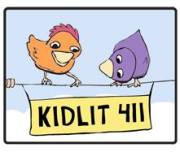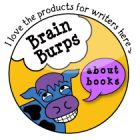14:14 PB ELEMENTS – Child of the Civil Rights Movement – THEME
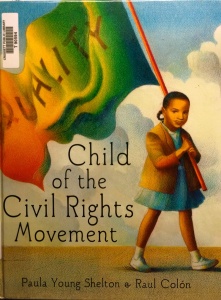 A front row seat in a theatre is fine, but the best view of the play is on the stage. Paula Young Shelton, daughter of civil rights leader Andrew Young, shares her view in this first person point-of-view story.
A front row seat in a theatre is fine, but the best view of the play is on the stage. Paula Young Shelton, daughter of civil rights leader Andrew Young, shares her view in this first person point-of-view story.
A Child of the Civil Rights Movement
author Paula Young Shelton
illustrator Raul Colon
(c) 2013, Schwartz & Wade Books,
a division of Random House
(1,796 words, AR Reading Level 4.8 )
It was a long-distance view of the turmoil in the south–black and white television images of burning buses, arrests and beatings–that drew Paula’s parents Andrew Young and Jean Childs Young back home to help fight violence and prejudice. They took Paula and her sisters onto the stage with them.
The element of THEME in Paula’s story is evident. There is a pursuit of equality and freedom. But supporting themes are just as important and critical in this story. From the first spread, the theme of family is strong. It becomes an immediate vehicle for the action, the emotion, the character development that takes place in this wonderful history.
“Mama was from Alabama.
Daddy was from Louisiana–
the Deep South.
They had been called bad names, treated badly, told, “You can’t do that!”
just because of the color of their skin.”
In subsequent ‘chapters’ (well designed sections the story) we follow Paula’s journey with her family to her account of “My First Protest,” which happened in a Holiday Inn restaurant when she was younger than four. She sat on the floor and cried loudly as her family was denied service.
In “Uncle Martin” we learn of the ‘extended’ family relationships that were such a driving force in the movement for equality. “The Civil Rights Family” shows us that this theme of family was full of emotion, sometimes disagreement, sometimes celebration, and good food.
“No matter how many people came to dinner, there was always enough to go around, enough to strengthen, enough to comfort the family of the civil rights movement.”
In “Selma to Montgomery” the pivotal event is remembered, as the Young’s entire family goes to Alabama to participate. Paula’s memory of this event is rich with the bonds of family as they share the passion for freedom with a world-wide family:
“I looked around and saw so many different kinds of people. Black and white. Young and old. Rich and poor. There were Jewish rabbis, Catholic priests, and lots and lots of Baptist ministers. There was even a man with one leg who everybody called Sunshine.
Like so many good books, the story cycles around to another scene with a television screen. Here again, in black and white flickering images, the Voting Rights Act of 1965 is signed by President Lyndon B. Johnson. Faces keenly familiar to Paula and her sisters appear on the screen beside him.
I found that the theme of family that Mrs. Shelton uses in her story adds so much validity to the overall theme of freedom and equality. What might be somewhat abstract concepts to young children are perhaps defined, clarified, and validated by the underlying theme of family that most children know.
I think this book is masterfully done, and should be out in every library and bookstore, not just in February but all year long. And if you haven’t seen the movie Selma yet, check this book out first–and read it to your kids.
(See a list of other reviewers’ posts in Christi’s latest post at Write Wild.)
14:14 PB ELEMENTS – The Extraordinary Music of Mr. Ives – CHARACTER
I myself wasn’t aware of this man’s story, or this author, until I pulled this book from the shelf and discovered this gold nugget of history and character. Charles Ives was not famous in his lifetime, but he is now considered a great American composer. The music inside him finally has finally been heard.
The Extraordinary Music of Mr. Ives
author & illustrator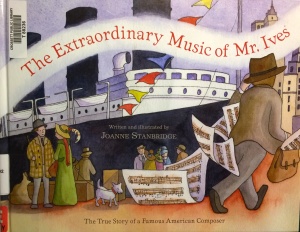
Joanne Stanbridge
(c) 2012,
Houghton Mifflin Books for Children
(1,260 words, AR Reading Level 3.0)
Centered around a huge tragedy many children will not be aware of, this story chronicles the emotional journey of a quiet insurance salesman in the early 1900’s. The story of Charles Ives reveals something else that many children may not be aware of: that the passions inside of us are valid and worthwhile elements of our character.
This is revealed in a subtle fashion, as we first find Mr. Ives hearing music around him in busy New York city:
The ocean liner Lusitania is sailing from Pier 54. The whistle is so loud, it shakes the ground. A few people cover their ears–but not Mr. Ives. He grabs that sound with both hands and shapes it into a song.
…
He writes music that is as busy as a city street. There are train whistles in it, and football games, and rowdy picnics and cars rushing past.
…
The click click click of adding machines and the murmur of good morning are so beautiful that he forgets to say good morning back.
Mr. Ives deals with numbers all day, but lets the music out at breaks. The music “lives inside him, like a friend.” We get the sense that our main character is lonely, except for his music, which many people don’t accept because it is different, “as bold as a city or as noisy as a traffic jam.”
I hope young readers will learn from this story that character is internal. It is not just how we react and interact with others and our circumstances, but why. Character arises from within people…from passion, sensitivity, emotion, devotion. Mr. Ives, his views unappreciated and his skills unrecognized, “writes his music down anyway.”
When the Lusitania is sunk by an enemy torpedo, Mr. Ives sadness overwhelms the music within him. The book beautifully reflects this silence with five wordless spreads illustrating the tragedy. The hush of the city is solid, and dampens his spirit. But then he hears a hurdy-gurdy player (organ grinder) slowly playing the music of a hymn:
“In the sweet bye and bye, we shall meet on that beautiful shore”
The music is “like a promise” and the crowd around him begins to sing. The music returns, and he “mingles the old tune with street sounds.” The new music is titled From Hanover Square north, at the End of a Tragic Day, the Voice of the People Again Arose.
A sadness remains. It is almost 50 years before his music is recognized and appreciated. But his passion, recorded over years in his loneliness, is eventually heard, loved, and accepted. The determination, deep emotion, and gifted sensitivity of a quiet man’s character stand the test of time.
(See a list of other reviewers’ posts in Christi’s latest post at Write Wild.)
14:14 PB ELEMENTS – Henry’s Freedom Box – PLOT
This book is a visual and historical treasure, relating the story of Henry ‘Box’ Brown, a famous slave who mailed himself to freedom in 1849. It is a Caldecott Honor Book, and it’s easy to see why the minute you look at the cover.
 Henry’s Freedom Box
Henry’s Freedom Box
author, Ellen Levine
illustrator, Kadir Nelson
(c) 2007, Scholastic Press
(1,260 words, AR Reading Level 3.0)
A child’s dark deep eyes strike you with a stare of determination and courage, seeming to carry a hidden sorrow. In the background a string of geese fly in a soft blue sky of freedom.
There are several elements used in this fine story, but I think the one most prominent to me is PLOT. There is rising action and falling action from page one, where uncertainty leads the reader to the next point on a line full of crises:
“Henry Brown wasn’t sure how old he was. Henry was a slave. And slaves weren’t allowed to know their birthdays.”
In the next spread, he feels his mother’s uncertainty. She says,
“Do you see those leaves blowing in the wind? They are torn from the trees like slave children are torn from their families.”
Then Henry’s sick master gives him to the master’s brother. The new master takes him to a city for factory work. The boss at the factory is harsh. Henry is lonely. Then he finds a young lady, and with approval of each of their masters, they marry. Life is good, a moment of hope, until his new wife Nancy tells that her master lost a lot of money, and she is afraid he will sell their children.
After days of worry and again, uncertainty, he gets news that his children and wife have been sold. Despair, but then another hope. With the help of a friend and a white doctor who was anti-slavery, he places himself in a box to be mailed north to freedom.
Despite his fears, worries about what could go wrong, as the plot follows his box through alternate moments of danger and safety on a long journey, Henry arrives in Pennsylvania. Dr. Smith’s friends open the crate. He comes out of his box, and claims the ‘birthday’ he never knew as his first day of freedom, March 30, 1849.
I like how the alternate uncertainties of both Henry’s emotions and his circumstances run parallel throughout the story line. The best plot is never about just circumstances, but also about feelings, and mental state, and about the growth in a character that we all long to see.
Watching this character move from uncertainty, to hope, to courage, to freedom, was a journey worth learning.
(See a list of other reviewers’ posts in Christi’s latest post at Write Wild.)
14:14 PB ELEMENTS – Creature Features – DIALOGUE
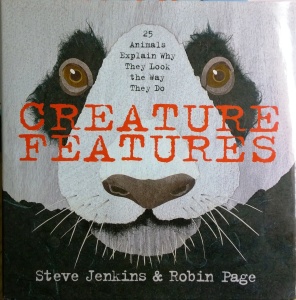 Creature Features
Creature Features
by Steve Jenkins & Robin Page
illustrator, Robin Page
(c) 2014, Houghton Mifflin Harcourt
(1,005 words, AR Reading Level 3.6)
This delightful book gives animals a voice, and while I am tempted to say one of the effective primary story elements is patterns, but I want to point out another that I find that lifts this book above straightforward fact to engage the young reader directly.
DIALOGUE is employed here in two ways. First, the book subtitle, “25 Animals Explain Why They Look the Way They Do,” hints at the format. When the book is opened, we find a memo form query (in marvelous typewriter font) to a tapir. “Dear tapir: Why is your nose crooked?”
The book then explains that the animal world has oddities, and promises to give the creatures a chance to explain their differences. The tapir then replies: “My nose isn’t always twisted. I bend it when I want to reach some tender leaves or fruit.”
 The rest of the book follows a predictable format, with a question (“Dear [creature highlighted], Why…”) on the left, which is followed by an answer from the creature on the right. Closeup illustrations of each animal’s face bring on the effect of a personal, one-on-one conversation. So, the format of the story is in dialogue.
The rest of the book follows a predictable format, with a question (“Dear [creature highlighted], Why…”) on the left, which is followed by an answer from the creature on the right. Closeup illustrations of each animal’s face bring on the effect of a personal, one-on-one conversation. So, the format of the story is in dialogue.
Second and notable is is the use of voice as a sub-element of dialogue. While the questions are simple, the answers are forthright, honest, and revealing of the character traits of the animals. Listen to the frank answers below.
“Dear frilled lizard: What are you wearing around your neck?”
“That’s my frill–extra skin that I unfurl when I feel threatened. Pretty scary, isn’t it?”“Dear Egyptian vulture: Why no feathers on your face?”
“Are you sure you want to know? Really? Okay, I’ll tell you. I stick my face into the bodies of the dead animals I eat, and feathers would get pretty messy…”
Jenkins and Page did a marvelous job here, I believe, of relating differences through dialogue that teaches about the animals, and with subtlety shows that differences are useful and purposeful. That translates to an important implication for kids today. Hopefully the notion will take hold.
(See a list of other reviewers’ posts in Christi’s latest post at Write Wild.)
14:14 PB ELEMENTS – Ocean Soup, Tide-Pool Poems – RHYME
 Ocean Soup, Tide-Pool Poems
Ocean Soup, Tide-Pool Poems
author, Stephen R. Swinburne
illustrator, Mary Peterson
(c) 2010, Charlesbridge
(1,697 words, AR Reading Level 3.8)
Before you balk at a book of poems with 1,697 words…realize that this is a non-fiction title and there are wonderful ‘sidebars’ of fascinating information.
So, on every page, there’s fun AND facts. What a combination!
I love books like this, and of course the element I’m highlighting is RHYME. Of course, there’s tons of word play as an element in poetry too. Consider the alliteration and consonance in the title: Ocean Soup – Tide-Pool Poems. But Stephen Swinburne has hauled right out of the water some marvelous rhyming verse in varied fun forms and clever perspectives as if he had been swimming there all along.
Did you know barnacles can rap?
“Don’t want no crab.
Don’t want no prawn.
All I wanna eat
is fresh plankton.
I do the filter feed, the filter feed.” (from Barnacle Rap)
With a sociable sea slug, urchins with self-esteem, a lurking sculpin not to be trusted, and a bully lobster, Swinburne relates tide-pool living with the an alluring humor and charm based on intriguing creature behaviors. So this book might also be a great example for the story element of character. The creatures interact, not to the rules of any defined plot, but to simply populate the life of ocean-side puddles.
It seems the author used rhyme to accomplish the sense that each creature, with its own poem, has its own place in the tide-pool habitat, albeit connected with every other creature in the pool in some way.
Mary Peterson’s full bleed illustrations capture the ebb and flow with movement that accompanies the rhythm and rhyme in Swinburne’s text, as well as that connectivity that his poems imply.
This is a delightful book, and perfect for a trip to the beach–virtual or real. If you go, just be sure to follow the advice of the seagull gazing down into the pool on page one:
“Tide-pool soup is really good,
a most delicious snack.
But careful! When you take a bite,
this soup might bite you back.”
(See a list of other reviewers’ posts in Christi’s latest post at Write Wild.)
14:14 PB ELEMENTS – Did Dinosaurs Eat People? – ???
Help me, please, with this book.
 Did Dinosaurs Eat People?
Did Dinosaurs Eat People?
author, Donna Bowman
illustrator, Marjorie Dumortier
(c) 2010, Picture Window Books
(a division of Capstone)
(1,594 words, AR Reading Level 3.4)
Plot? Not a drop.
Theme? Obscure. Too simple–dinosaurs.
Conflict? Nope. They’re extinct. And so is their conflict.
Pacing? Random…more like browsing on the internet. Or really, more like channel surfing.
Word play? Nah.
No Rhyme. Not even internal.
Really, no Beginning or Ending.
Character? Not much. I mean, there’s meat eaters and veggie lovers.
Dialogue? Roaaarhhh! So much for that.
Don’t get me wrong. The book is clever. I picked it up because the topic has been a favorite since I was 5 and first marveled at a two-page-spread brontosaurus skeleton in the Golden Book Encyclopedia.
So, what’s left? I guess it must be PATTERN. The cleverness I refer to is in the structure of the text. The title clearly declares this story element, which acts as the lure of the book from the outset.
A Q&A approach is bound to intrigue a shelf-browser of any age. Author Bowman has taken “questions kids have about dinosaurs” (clever subtitle) and arranged them in a pattern throughout Dumortier’s fun pen-and-watercolor illustrations with paragraphic answers.
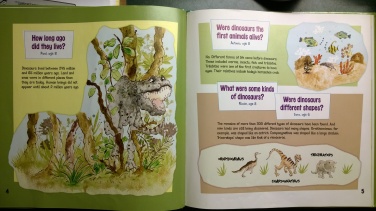 Another clever feature about this approach is that each question is accompanied by a child’s name and age: “Antonio, age 8” “Sara, age 6” “Hollister, age 7” Even some questions are listed from schools: “How did dinosaurs go to the bathroom? Partin Elementary School.”
Another clever feature about this approach is that each question is accompanied by a child’s name and age: “Antonio, age 8” “Sara, age 6” “Hollister, age 7” Even some questions are listed from schools: “How did dinosaurs go to the bathroom? Partin Elementary School.”
This pattern of questions and answers (questions I suppose from real kids and real schools) is the hook and draw for this book.
Not to mention that the illustrations are fun–there’s comedy in every scene (another form of pattern). A tyrannosaurus on page nine holds his nose standing beside a stinky pile of diplodocus poop. (Must have been those ferns.)
Not surprising, this is one in a group of trade non-fiction books, the Kids’ Questions series by the producer. I’m sure the other titles employ the same pattern technique.
What are some other ways this Q&A pattern could be applied? Would this pattern be better if accompanied by pictures of the kids asking the questions? How could this pattern play out in digital books or apps? Let me know what you think in your comments.
Meanwhile, watch where you step. You may be walking where diplodocuses have plod.
(See a list of other reviewers posts in Christi’s latest post at Write Wild.)
14:14 PB ELEMENTS – One Giant Leap – PACING
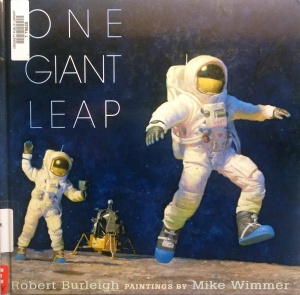 When I told my 6-year old granddaughter that I had actually watched this real story take place live on television…she didn’t seem impressed. It made me wonder if a child in today’s world can imagine the breath-holding tension and awe that millions experienced in that moment. Using the story element of PACING, I think this book makes a valiant effort to relate the immensity of the event.
When I told my 6-year old granddaughter that I had actually watched this real story take place live on television…she didn’t seem impressed. It made me wonder if a child in today’s world can imagine the breath-holding tension and awe that millions experienced in that moment. Using the story element of PACING, I think this book makes a valiant effort to relate the immensity of the event.
One Giant Leap
author, Robert Burleigh
illustrator, Mike Wimmer
(c) 2009, Philomel Books
(1,461 words, AR Reading Level 3.0)
It took some reflection to determine which story element to highlight for this title. I find good use of word play, with imagery and metaphor. Of course there’s plot, with the events leading to climax (the ‘one small step’) and resolution (return to earth).
But glancing back at each page, I see a solid pattern of pacing the author employed to set, maintain, and increase tension and page-turn for the reader.
Consider the last lines of the text for each sequential spread:
“At 8000 feet, it tilts and straightens. Brakes its descent. Slows. Drifts down through space.”
“The surface gouged and cratered…Like a battlefield from some ancient war.”
“He glances again at the flashing dial: fuel running short. Where can he land?””The small craft touches down. Whew!”
“We did it. We’re here.”
“No water. No wind. No sound. No life at all. Unbelievable.”
“In orbit, Michael Collins listens. And waits.”
The teases above make the reader ask, respectively:
Will it land safely?
Battlefield? Dangerous?
Not enough fuel? Will they land in a hole?
Whew! Now what?
Great! What do they do now?
Are they about to be the first life there?
What is Collins waiting for?
As the reader asks these questions internally, the tension grows, the excitement expands. I think that the pacing helps relate the feeling of ‘first ever-ness’ that rightfully accompanies this historical achievement.
Pacing can be related by anticipation and surprise, flow, cause and effect, questions. All of these tools seem to be in play with this story, to great effect. Thanks Mr. Burleigh.
I’ll read this again to my granddaughter, and pause just a little bit more before each page turn, to add my own pacing based on experience. But of course, she’ll view the moment not in black and white, but in full color. Thanks Mr. Wimmer.
Who knows? In her lifetime, she might be on vacation to the moon when she watches the first man or woman step onto Mars.
(See a list of other reviewers posts in Christi’s latest post at Write Wild.)
14:14 PB ELEMENTS – Mammoths on the Move – RHYME
My picture book today was a great title in anticipation of our first possible potential of a snow sprinkle in southeast Arkansas (tomorrow night). Probably, we’ll have just a smidgen of ice. But this is a curl-up-in-a-thick-blanket book in more ways than one.
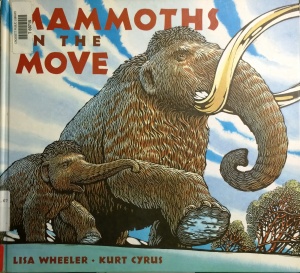 Mammoths on the Move, by Lisa Wheeler
Mammoths on the Move, by Lisa Wheeler
illustrated by Kurt Cyrus
(c) 2006, Harcourt
(472 words, AR Reading Level 3.9)
Mammoths on the Move makes excellent use of poetic form and the element of RHYME in relating factual details that support a focus on migration, a vital aspect of woolly mammoth life.
What kid (or grown-up-old guy like me) isn’t entranced, first of all, by these majestic creatures. Lisa Wheeler took her enchantment and put it in methodical, carefully metered verse to produce a perfect rhyming story. With quatrains that weave amazing facts about mammoth life and culture around the aspect of migration, she embeds us with the herd as it moves to warmer grounds.
Kurt Cyrus provides illustrations that bring us up close and personal. In the first spread we stand beneath a mountain of wool, near lumbering trunk-like legs, to read:
“Fourteen thousand years ago
the north was mostly ice and snow.
But wooly mammoths didn’t care–
these beasts had comfy coats of hair.”
The use of rhyme sets up a sense of deliberation, a determination that mimics the steady intent and force and purpose of the mammoths in their migration.
I love Lisa’s varied refrains, which appear after either one or two stanzas throughout the journey.
“Fuzzy, shaggy, / snarly, snaggly, / wonderful / woolly mammoth.”
“Grinding, gnawing, / chewing, chawing, / wise and woolly mammoth.”
 The refrains are used to emphasize facts related in the quatrains. Both rhyme, which occurs internally and in an AABB pattern in the quatrains, and poetic form are used effectively. The sense of structure, the meter of “left-foot, right-foot, left-foot, right-foot,” supports the long and steady walk of the herd to their destination, with their rests and pauses emphasized by the refrains.
The refrains are used to emphasize facts related in the quatrains. Both rhyme, which occurs internally and in an AABB pattern in the quatrains, and poetic form are used effectively. The sense of structure, the meter of “left-foot, right-foot, left-foot, right-foot,” supports the long and steady walk of the herd to their destination, with their rests and pauses emphasized by the refrains.
A read-aloud for sure. And as you read it, deepen your voice, add some grunts between stanzas, and warm up to the wonder of a child beside you eyes-wide open in awe at these marvelous beasts.
Share, if you will, how you’ve seen rhyme used well in some of your favorite non-fiction books.
(See a list of other reviewers posts in Christi’s latest post at Write Wild.)
14:14 PB ELEMENT – I Wonder Why Creepy-Crawlies – PATTERNS
Non-fiction picture books differ from picture books–by definition, of course. But there are other ways they differ as well. The way that picture book elements apply, and are effective, differ somewhat for the facts, figures, history, and information that are provided.
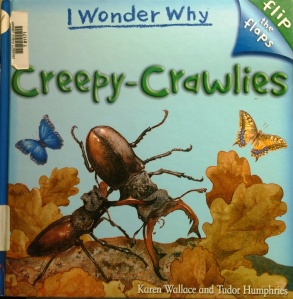 While I can’t seem to put my finger on just how they differ in that aspect, I kinda get a sense of it from today’s title.
While I can’t seem to put my finger on just how they differ in that aspect, I kinda get a sense of it from today’s title.
I Wonder Why, Creepy-Crawlies
Karen Wallace, author
illustrated by Tudor Humphries
(c) 2008, Kingfisher (Henry Holt & Co.)
(703 words, Flesch-Kincaid Grade Level 3.8)
Wallace and illustrator Humphries have come together on a fun topic to deliver a delightful eye and mind pleaser smack full of fun facts. From publisher Kingfisher (an imprint of Henry Holt & Co.) in a series called “I Wonder Why” comes “Creepy-Crawlies.”
With the first page definition through six more sections, this book uses, in a unique way, the picture book element of PATTERNS. Imagine the surprise of a young reader when he turns past the contents page to discover a bug-littered spread with a half-page of questions leaping outward!
Yes, the pattern here is physical, not just in the text or story. I immediately was impressed with the idea of half-pages with questions jutting out between the spread. A quick peek behind the question page reveals the answers to common questions that a kid may have about the creepy-crawly being featured.
Sure, the text employs patterns as well. Expected Q&A’s per critter–‘three’ questions per critter, “three” answers per critter. Numbered. A reliable pattern, surrounded by easily anticipated full-bleed, full-color, labeled illustrations.
When I leave the Ladybugs pages, I can expect the same on the Ants pages. Same on the Spiders pages. Same on the Butterflies pages.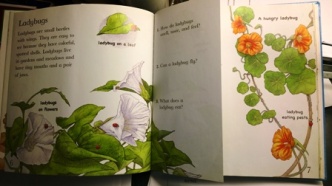
While I’m not sure I’d know what to call this pattern combination, perhaps the publishers have coined the proper term. It’s in the corner of the cover: “flip the flaps.”
I like it. The patterns mentally engage the reader (setting up expectations) and physically engage the reader (flipping the flaps).
What kinds of patterns have you seen that are uniquely done? Are they effective for the content and/or the story? Share your comments.
(See a list of other reviewers posts in Christi’s latest post at Write Wild.)
14:14 PB ELEMENTS – Desert Animal Adaptations – WORD PLAY
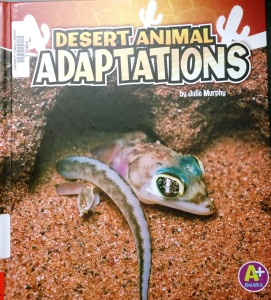 Desert Animal Adaptations, by Julie Murphy, published by Capstone Press, (c) 2012.
Desert Animal Adaptations, by Julie Murphy, published by Capstone Press, (c) 2012.
(473 words, AR Reading Level 2.9)
A non-fiction picture book of facts with vivid photos of desert animals, this volume is one in a series by Capstone with simple text–but not TOO simple. Having just finished the Lyrical Language Lab course by Renee LaTulippe, I’m keenly sensitive to the use of lyrical language in prose. Immediately I recognized what made this parade of facts fun for me.
To portray desert animal adaptations, Murphy spices her easy to read, short, simple paragraphs with effective alliteration, consonance, and assonance, along with a scattering of internal rhyme. Murphy employs subtle word-play techniques, but doesn’t overdo them:
Could you keep your cool in a hot desert?
…fur reflects…
…zips across hot sand without sinking…
…sips from a saguaro…
…camels keep…
…wooly underwear…
…yaks jacket…
…double rows of eyelashes…nostrils that close…eyes and nose…
Julie Murphy did it wonderfully. The use of word play creates a flow throughout the story, and makes the reading easy. Me? I’m wordy. Knowing that’s a weakness in my writing, I try to avoid it. If I had attempted this book several years ago, I’d have gone full-force with word play. There would be stanzas of stacked meter, and flung-about rhyme.
I know better now. I wonder if sometimes the effect of forcing poetic form onto facts might overshadow or minimize important points. I think, for this book, it might have clouded the theme of animal adaptation, and made the book less effective as a learning tool. As it is, the facts are clear and direct…they are just more tasty because of the spice of word play.
Take note. I said sometimes. There are some wonderful non-fiction picture books in the market where the power of rhyme and lyrical language in poetic form are effective and useful. I’ll share some soon.
Meanwhile, what do you think about word play in picture books? Is it more useful for some topics than in others? Does it ever detract, or is it always useful? Your comments are more than welcome–they’re wanted!
(See a list of other reviewers posts in Christi’s latest post at Write Wild.)


